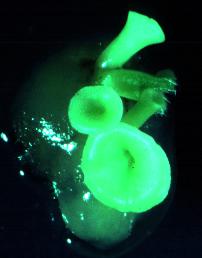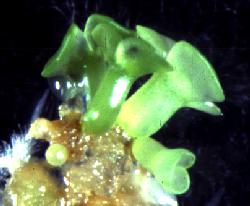The presence of exogenous 2,4-D can interfere with proper embryo development, either by inhibiting histodifferentiation, of by preventing the formation of bilateral symmetry. The addition of activated charcoal to the medium to adsorb 2,4-D will normalize development. The photos below show somatic embryos induced on 2,4-D, and which underwent histodifferentiation without (left) or with (right) activated charcoal.


For more information on the use of charcoal, see:
J. P. Ranch, L. Oglesby, and A. C. Zielinski. 1986. Plant regeneration from tissue cultures of soybean by somatic embryogenesis. In: Cell culture and somatic cell genetics of plants, edited by I. K. Vasil, New York:Academic Press, p. 97-110.
M. A. Bailey, H. R. Boerma, and W. A. Parrott. 1993. Genotype effects on proliferative embryogenesis and plant regeneration of soybean. In Vitro Cell.Dev.Biol. 29P:102-108.
These references are relevant, though they are not on soybean:
T. J. Cooke, R. H. Racusen, and J. D. Cohen. 1993. The role of auxin in plant embryogenesis. Plant Cell 5:1494-1495.
C.-m. Liu, Z.-H. Xu, and N.-H. Chua. 1993. Auxin polar transport is essential for the establishment of bilateral symmetry during early plant embryogenesis. Plant Cell 5:621-630.
J. W. Wilson and P. M. W. Wilson. 1993. Mechanisms of auxin regulation of structural and physiological polarity in plants, tissues, cells and embryos. Aust.J.Pl.Physiol. 20:555-571.
